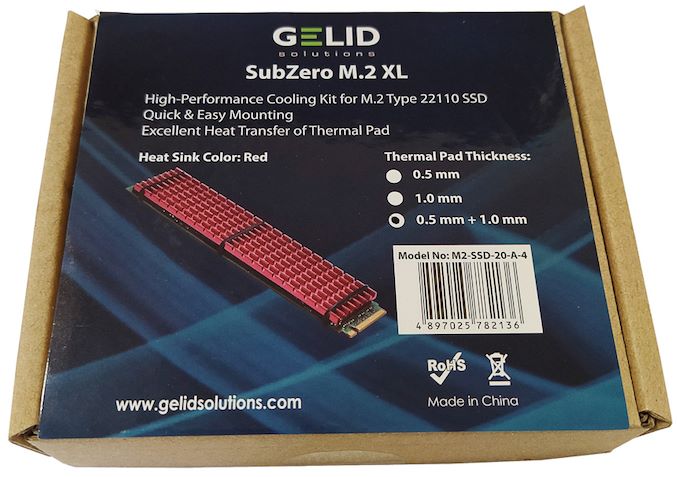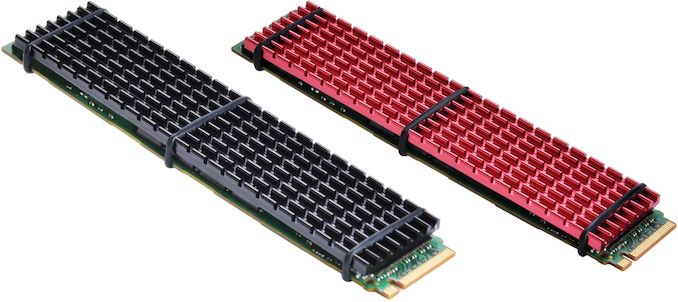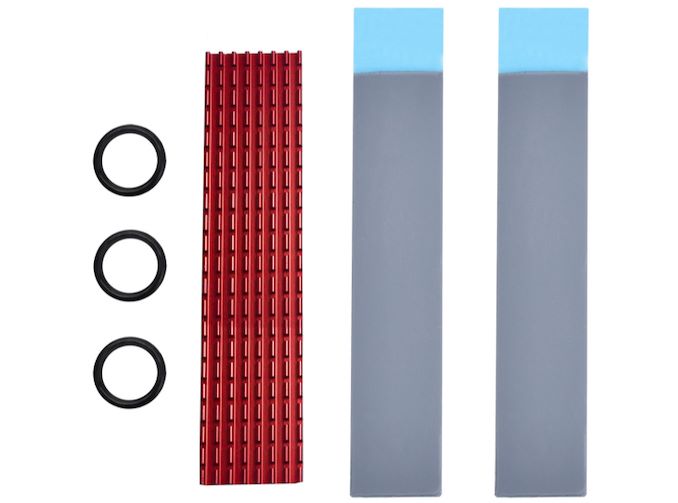GELID Unveils SubZero M.2 XL: A DIY Cooling System for M.2-22110 SSDs
by Anton Shilov on December 3, 2019 6:00 PM EST- Posted in
- SSDs
- Cases/Cooling/PSUs
- M.2
- Optane 905P
- Gelid
- M.2-22110

GELID has introduced a rather unusual product: an aftermarket heatsink designed for SSDs that use the server/workstation-oriented M.2-22110 form-factor. The SubZero M.2 XL aluminum heatsink is shipped with two thermal pads as well as silicone fixtures and is designed to keep these drives from overheating and and performing more consistently under high loads
The majority of client SSDs these days use an M.2-2280 form-factor, as this is the largest drive that most desktops and virtually all notebooks can accommodate. By contrast, M.2-22110 drives are somewhat more common for server/workstation-grade drives, as those systems have more space and there's a need for features such as power loss protection. Nonetheless, there's still some overlap with enthusiast-class desktop boards, which can include an M.2-22110 slot or two just in case.
At present, the best-known client M.2-22110 SSD is Intel’s Optane 905P M.2, which uses 3D XPoint memory and is among the highest performing drives available today. Not so coincidentally, the Optane 905P M.2 is also known for thermal throttling under high loads if the drive is left bare. So for 905Ps that didn't come with a heatsink, GELID’s SubZero M.2 XL fills a specific niche.
| GELID's SubZero XL for M.2-22110 SSDs | |||
| HS-M2-SSD-20 | |||
| Heatsink Dimensions | 100 х 20 х 3 mm | ||
| Heatsink Material | Aluminum | ||
| Thermal Pad Thickness | 0.5 & 1 mm | ||
| Thermal Pad Conductivity | 12 W/mK | ||
| Thermal Pad Hardness | 35 Shore | ||
| Weight | 45 grams | ||
| Bundle | Heatsink x1 Thermal Pad x2 Fixtures x3 |
||
GELID’s SubZero M.2 XL heatsinks are available in black and red for an MSRP of $10/€9.
Related Reading:
- EKWB Begins Selling Heatsink for Intel’s Optane 905P M.2 SSD
- The Enterpise TLC Storage Era Begins: Rounding Up 13 SSDs With Samsung, Intel, and Memblaze
- Intel Expands Optane 905P SSDs To 1.5TB
Source: GELID












16 Comments
View All Comments
bENDEJO - Tuesday, December 3, 2019 - link
What, no LEDs"drexnx - Tuesday, December 3, 2019 - link
silicon fixtures aka rubber bands?hey, if it works, it works.
deil - Wednesday, December 4, 2019 - link
better than expected AND maybe it will fit into laptop?RoC_17 - Tuesday, December 3, 2019 - link
They don't fill a specific niche, they cool down my Evo 970's NAND down to 50 degrees C under sustained load, and the controller to 65 max (from 82!). Given it costs under 15 EUR for end-consumers, (not exactly these, but same stuff from Aquatuning) that should be attached out of the box.edzieba - Wednesday, December 4, 2019 - link
Don't cool the NAND dies themselves!They heat themselves up to operating temperature by design, cooling them means they just continually dump out power trying to hit temperature, and will be operating with a lower endurance (simplified: higher operating temperature = lower energy input to set/erase cells = less degradation of each cell per write/erase cycle).
Spunjji - Wednesday, December 4, 2019 - link
As long as this doesn't catch significant airflow, it might actually help a little by spreading heat from the controller / active dies to inactive dies.Billy Tallis - Thursday, December 5, 2019 - link
If you're going to be running lots of benchmarks trying to hit the highest speeds possible, you will have to cool both the NAND and the controller. If you only care about performance during real-world usage, then you don't need to cool either (except for Optane 905P and arguably Phison E16 drives).Thud2 - Tuesday, December 3, 2019 - link
Do you mean Silicone Fixtures?eek2121 - Wednesday, December 4, 2019 - link
m.2 seemed like a great idea at first. The promise of PCIE speeds in a small form factor is certainly appealing. However, 2 things that weren't accounted for are cooling and physical space for the flash modules themselves. I expect that 4-8 tb will be the most we'll see with the current technology. You can't even effectly cool the drive, since the underside is almost always inaccessible. The heatsinks do help, but unless we figure out a better way to do things we are kind of stuck.deil - Wednesday, December 4, 2019 - link
m.2 is great, just nobody thought about colling at the time. I've seen mobo with shields, both under and over the ssd. I guess with thick thermal pad it will work